Rafael Alberti - Painter
Discover Alberti's pictorial side
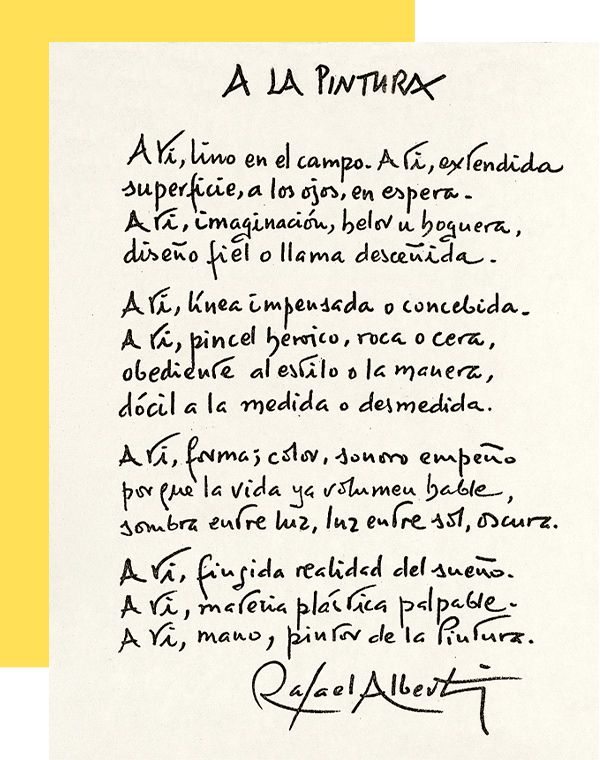
Rafael Alberti's first vocation was painting, already evident in his early years when in El Puerto de Santa María he drew the ships that arrived there.
But his real discovery of painting took place in 1917, when, for family reasons, he moved to Madrid and entered for the first time the Prado Museum, to which he would pay homage years later, from his Argentine exile, in one of his greatest books: A la Pintura, dedicated to Picasso. In it will be reflected not only his dazzlement towards painting and towards one of the most beautiful museums in the world, but also his meticulous knowledge of the pictorial schools, the techniques and procedures used, the style of each painter.
His first collective exhibition was in 1920 at the Salón Nacional de Otoño in Madrid, together with Vázquez Díaz, and two years later he exhibited at the Ateneo in the same city.
His avant-garde painting -which more than one critic today has reminded him of Kandinsky- will not be his definitive one since, after the death of his father, the first verses will emerge from his pen...
Without completely abandoning his pictorial vocation, his life opened up to what would become the center of his inspiration: poetry. Alberti fused both vocations in the creation of his “lyricographies”, in which he drew his verses (“give me now the madness / that at that time had me / to paint poetry with the brush of painting”). Underneath the poet always beats the painter and vice versa. His poetry is plastic, full of color, luminous like his painting. Before writing it, according to him, he had to see it drawn. And his painting has all the lyricism of his verses, the rhythm of his metric compositions. Picasso, in a drawing he gave him as a gift, dedicated it to him: “From the poet Pablo Picasso to the painter Rafael Alberti”.
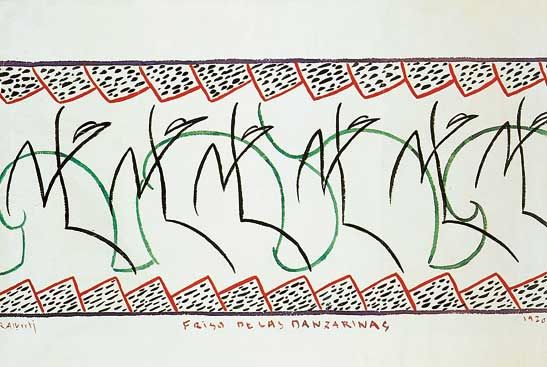 Friso de las danzarinas (Madrid 1920)
Friso de las danzarinas (Madrid 1920)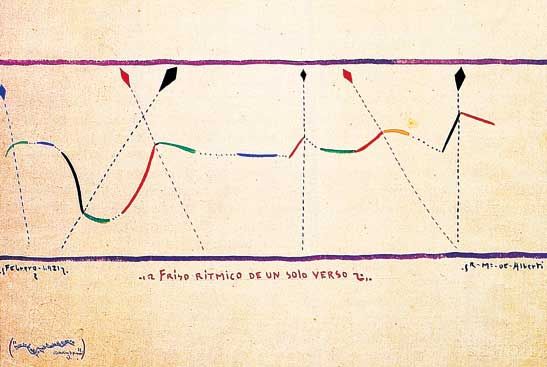 Friso rítmico de un solo verso (Madrid 1923)
Friso rítmico de un solo verso (Madrid 1923)His work as a painter, although it will be accentuated later in Italy, he will never abandon it. Thus, during his Argentine exile, in addition to painting to exhibit in 1947 at the Arte Bella salon in Montevideo, he will also show his drawings and liricographies in the V room and in the Bonino Gallery in Buenos Aires.
In 1954, and again in the Argentine capital, he will make a new exhibition at Galatea Gallery and the following year Bonino Gallery will publish the folder Liricografías, poemas ilustrados con diez dibujos en color (Lyricographies, poems illustrated with ten color drawings). In 1960 he will hang his paintings in Acquarella Gallery (Caracas), and in the National Historical Museum of Bogota. His artistic sense will take him to decorate all kinds of furniture and objects (fans, mirrors, boxes, doors), as a playful activity for friends and to please punctual orders that were made to him.
His arrival in Italy in 1963, will make even more evident his Italian roots -Alberti Merello- with his fourteen-year stay in the Trastevere district. There, perhaps because of the language barrier, he expresses himself much better with his brushes, and he will relate, more than with poets, with painters and engravers such as Quatrucci, Vedova, Cagli or Mastroianni. With the latter he will learn different forms of engraving, among them in lead, very little known, and which astonished Picasso himself when, during one of his visits to Mougins, Alberti showed them to him. His restless personality will experiment with all techniques: tempera, watercolor, drypoint, collages,.... His portfolios of serigraphs and lithographs will be exhibited in the most prestigious galleries in Italy.
Alberti's personal vision for graphic design led him to work as a poster designer. Some of his posters spread throughout Italy, such as Rapporto tra l'uomo e l'ambiente naturale and No allo sterminio degli ucelli, both in defense of nature and the environment. His friendship with Joan Miró, Antoni Tàpies, Manolo Rivera, Antonio Saura, Robert Motherwell, Roberto Matta..., will make him collaborate in joint works with many of them.
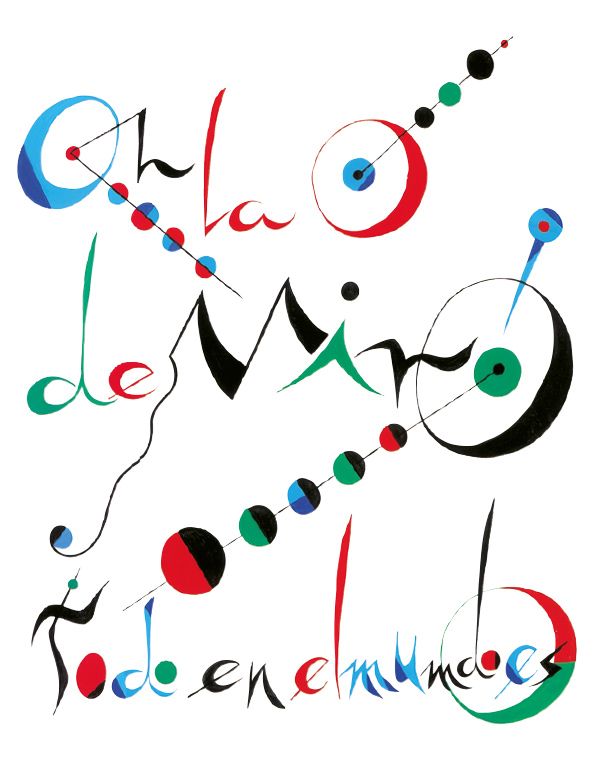
In 1964, he presents X Sonetos romanos, etchings and lead engravings, with which he wins the first prize for engraving at the V Rasegna d'Arte Figurativo di Roma, in 1966.
That same year, on the occasion of Pablo Picasso's 85th birthday, he produced a set of lead engravings and original color drawings, Los ojos de Picasso, which were exhibited at the Galleria Il Segno in Rome. And in 1970 he finishes his silkscreen portfolio Corrida, in which he highlights his very personal vision of the bullfighting festival and interprets all the suertes of bullfighting. In 1971, Homage to Picasso, a folder of engravings, on the occasion of the Malaga painter's ninetieth birthday.
At the Rondanini Gallery in Rome, in 1972, in the exhibition entitled La palabra y el signo, he presents the folder El lirismo del alfabeto, consisting of twenty-six silkscreen prints in color and as many in black and white. That same year he exhibits all his graphic work in the same gallery, on the occasion of the tribute paid to him for his seventieth birthday. In 1975 the Rodriguez Acosta Foundation of Granada commissioned him the portfolioNunca fui a Granada. His silkscreen folder Canción de amor will appear in 1977.
It will also be in Rome where Alberti will create The Goose-Torse game, in silkscreen-printed wood, as a beautiful children's game where, accompanied by the figures of these two animals, we can go around the board, according to the ancient rules of the well-known “game of the goose”.
It will also be in Rome where Alberti will create The Game of the Goose and the Bull, in screen-printed wood, as a beautiful children's game where, accompanied by the figures of these two animals, we can go all over the board, according to the ancient rules of the well-known “game of the goose”. There he will also design drawings to reproduce on beautiful silk scarves and paint directly on blouses and dresses, including a capote de paseo for Luis Miguel Dominguín. Rafael Alberti's pictorial work is characterized by luminosity, where the colors, preferably pastels, are combined and blurred with a wisdom in contrast to those youthful strokes that are astonishing to have been made at such an advanced age.
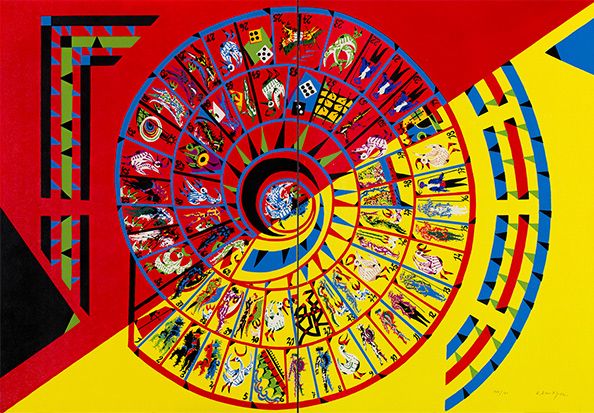
In 1970, while Alberti was still in Italy, the College of Architects of Catalonia and the Balearic Islands organized a grandiose exhibition of his graphic and poetic work in Barcelona.
After his return to Spain, his work as a painter will be requested for several years to make posters for the Summer Courses of the Complutense University in El Escorial and the same held in Almeria. He will also be commissioned, among others, posters for Encuentros en el Mediterráneo, A orillas del Guadalquivir, Bienal de Flamenco de Sevilla, Homenaje a Machado, Claveles rojos para Mao-Tse Tung, Amnistía Internacional, Carnaval de Cádiz, Feria de El Puerto de Santa María, Centenario Jorge Guillén, Centenario Gerardo Diego, etc... His drawings illustrate his own and other authors' books, album covers, as well as bullfighting posters, campaigns of the P.C. His participation in the world of graphic design has been very abundant and praised, for his unmistakable personality that makes it impossible not to instantly recognize his authorship.
In 1985 he presents in Madrid Las 4 estaciones, a folder composed of twelve sheets, of which a handwritten poem and two drawings correspond to each season of the year.
In 1990 he created the folder Bestiario. In 1997 he presents his Todo Alberti folder, color engravings grouped in four sections: love, nature, bulls and sea. ARCO, the Contemporary Art Fair, will pay tribute to the painter in 1991 with an anthological exhibition of his painting, for which he will create the poster.
In contrast to the multicolored arabesques of other periods and the goldsmith's meticulousness in the smallest details, the last stage of Rafael Alberti's painting is characterized, with some exceptions, by the use of a single line, sober, of a single stroke, as an adaptation of age to his pictorial activity. It is worth mentioning, above all, the exuberant female nudes in black or those of adolescents where he seems to put to the test, once again, his prodigious pulse.
